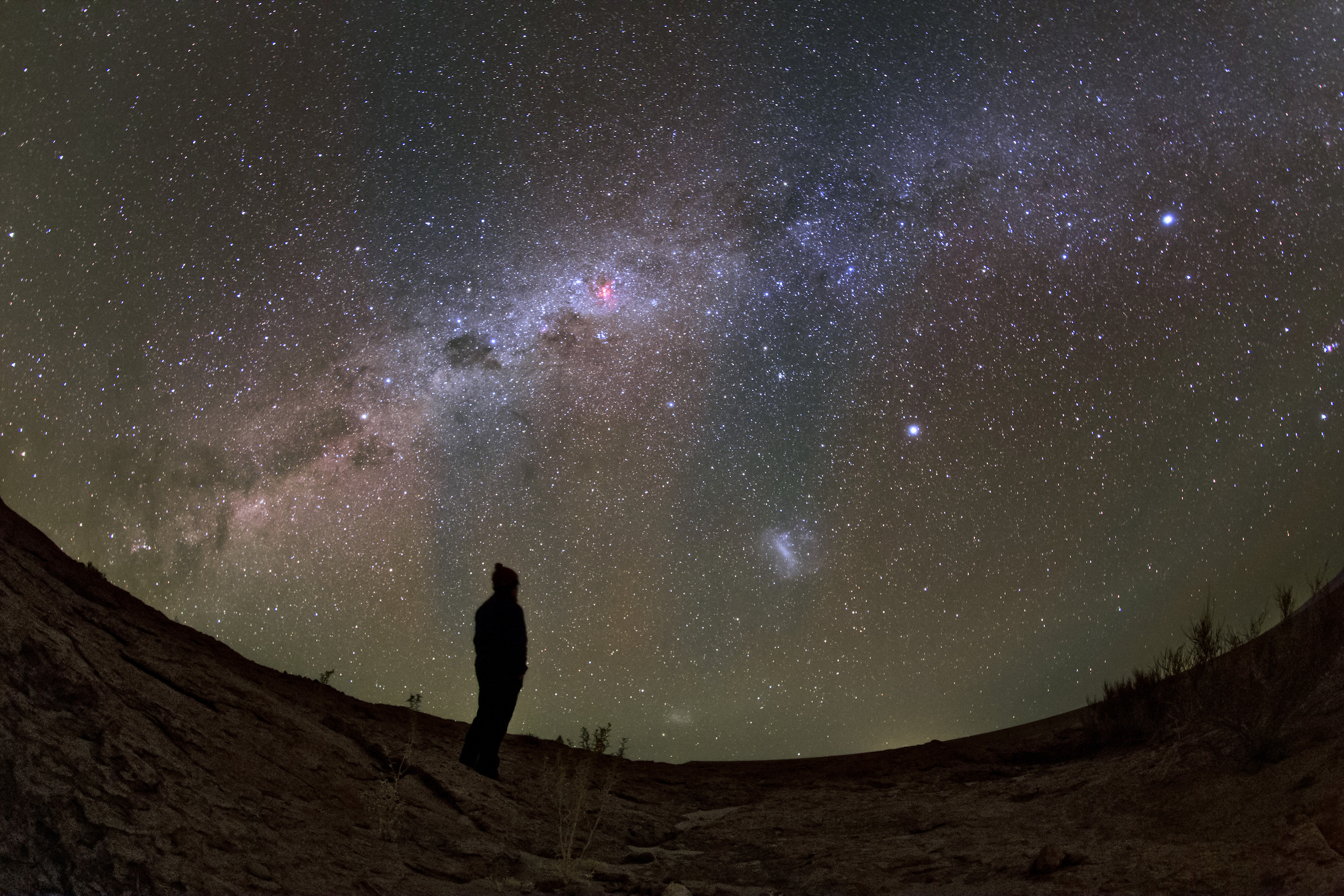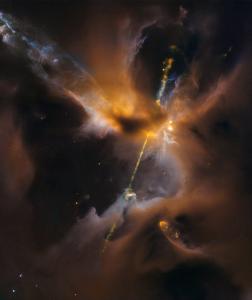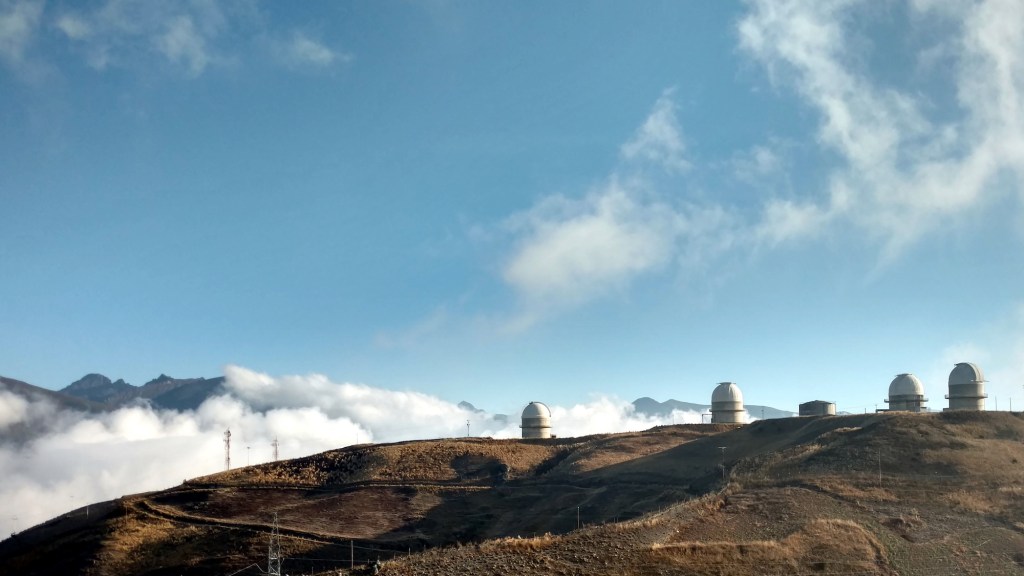Two Last Names: Reflections From A Colombian Astronomer
Countries across Latin America have very different struggles, and successes, in producing and retaining astronomy talent.

Gazing at the universe from an ESO site in Chile. Credit: ESO/B. Tafreshi (twanight.org)
This story was produced by Science Friday and América Futura as part of our “Astronomy: Made in Latin America” newsletter and series. It is available in Spanish here.
“Which one of these is your last name?” The tone and words, spoken in an English that was hard to pinpoint, suggested that this was not just a routine question for filling out paperwork. “If it’s a last name, why isn’t it hyphenated?” It’s like asking why the road from Alaska to Patagonia is called the Pan-American Highway if it doesn’t cross the Darién Gap. But this person didn’t want to hear historical or sociocultural explanations. He had a certain worldview, and my existence didn’t fit into it. “Occupation?” Astronomer. “And that can be studied in your country?”
There aren’t very many of us professional astronomers in the world, let alone in Latin America. The International Astronomical Union (IAU), the international organization advancing astronomy worldwide, has 12,734 members from 85 countries. Around six out of every 100 professional astronomers, and 8 out of every 100 humans, live in Latin America. So, those of us who come from that part of the world are not exceptions in the international astronomical community. But we don’t loom large in the collective imagination, even in our own countries.

Ask someone to close their eyes and think of a person who works in astronomy. Is it a woman or a man? What language do they speak? What’s their skin color? The answer may vary, but it’s unlikely they’re imagining Guillermo Haro Barraza or María Cristina Pineda Suazo. Have they ever heard or seen an astronomer talk about a discovery on the radio or on TV in their language? In their country, like in mine, do geomagnetic storms have to compete with celebrity news? Given how little we see and hear of our astronomers—and scientists in general—in Latin America, it’s a miracle we keep producing them.
Hugo Levato, an astronomer from Argentina who put together one of the few studies about formal astronomy education in Latin America, divided our countries into three categories. The first category consists of countries totally absent from the international astronomy scene—as if Paraguay, Nicaragua, and El Salvador didn’t look at the sky. This category also has a few countries with just one or two IAU members, whom I naively imagine like proud Don Quixotes observing the heavens from Bolivia, Cuba, or Perú. Although Peru left its mark on 20th century astronomy, the fact is that, despite its privileged clear skies and rich pre-Columbian history of observing the cosmos, it is absent from modern astronomy.
The study’s second category consists of countries with at least 10 researchers where astronomy was offered as a specialization within a physics major. Among them are Uruguay, Honduras, and Colombia, although a lot has changed in the more than 15 years since the article’s publication. Costa Rica, which received its first planetarium as a donation from Japan in 2002 and now sends students to finish their studies at the best universities in the world, can be added to this list. Colombia has also raised the bar, offering doctorate degrees and establishing itself as an exporter of scientific talent. However, its scores on international physics and mathematics exams show that most of its high school students fall below average compared to students from industrialized countries.
The last category is made up of five countries that had “closed the cycle” of producing astronomers at the doctoral level, maintaining research ecosystems with institutes, PhD scientists, and professors. But Venezuela’s political and social crisis has cost the country its leadership in the field, eroding the system that maintained a high level of astronomy research, despite the limitations. Mexico, Argentina, and Brazil are powerhouses in the natural sciences, though the ups and downs of their governments raise concerns about their stability.

Chile stands in a class of its own as the gateway to the clearest skies on Earth. The exceptionally clear and dry skies of the Atacama Desert, which are cloudless almost 300 days a year, have attracted more than half of the world’s astronomy infrastructure. It is impossible to imagine modern astronomy without the Cerro Tololo, La Silla, or Las Campanas observatories, without the ALMA or Llano de Chajnantor antennas. It is impossible to imagine the future of astronomy without the Giant Magellan Telescope, the ESO’s Extremely Large Telescope, or the Vera C. Rubin Observatory.
Chile’s astronomical wealth extends beyond its borders. María Teresa Ruiz González and her Children of the Stars have spread to pages and screens across Latin America much like Carl Sagan and his TV program “Cosmos.” How far will the seeds spread that she and many other astronomy lovers planted in our countries? I’d like to think they’ve made our complex and unequal societies a little better.
My suspicion turns into certainty when I see the faces of young researchers attending LARIM, the Latin American regional IAU meeting, or when I read the words of so many others looking for an internship or a doctoral position. I see the passion and rigor with which they embrace their work, and I hide the frustrations that I and many other Latin American researchers feel behind a huge smile. I forget the lines for visas that we use to justify our existence in the countries that have the resources to exploit our talent. Memories of prejudice, ignorance, and mistrust fade away. I keep the bad memories to myself because I am witnessing a miracle: Someone in our corner of the world feels they can push the boundaries of human knowledge to a far-off place in the universe.

Each of them is a “Latin American astronomer,” with two last names that make them stand out from the rest—not names they should shorten or join with hyphens in order to share their discoveries with the world. They are shaped by teachers who have chosen to stay in their countries, even though they know their students’ potential is only valued in other countries. They have chosen to look up to the sky in societies where it is easier to keep looking down. They are not yet Edwin Hubble or Cecilia Payne Gaposchkin, but they face the universe with a kind of passion and creativity that is only born in our countries. They must persevere and do their best to see everything, to understand everything, and then tell it all, because they come from the garden of forking paths, where a visa or a prejudice could close one door, forcing them to invent another way.
They must share their stories so that others know there is someone just like them—someone who looked beyond the atmosphere and listened to the universe’s secrets in our languages and our accents. They must share their stories so that the flame of curiosity burns forever in our nations, and so that we never feel we have less of a right than anyone else to understand the sky that covers us all.
The author thanks Luis Nuñez de Villavicencio Martinez, Santiago González Gaitán, Anais Moller, Yara L. Jaffe, and Juan Rafael Martinez Galarza for the conversations that inspired this article.
This story was translated from Spanish by Laura González.
Juan Diego Soler Pulido is a researcher at the Institute of Space Astrophysics and Planetology in Rome, Italy. He holds a doctorate in astronomy and astrophysics from the University of Toronto and is the author of Relatos del confín del mundo (y el universo) and Lejos de casa. He has written about science for El Espectador since 2011.